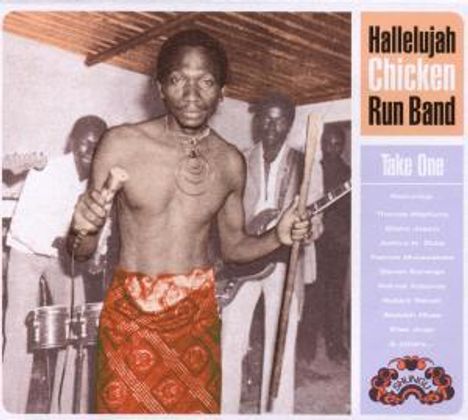Hallelujah Chicken Run Band: Take One (1974-79) auf CD
Take One (1974-79)
Herkömmliche CD, die mit allen CD-Playern und Computerlaufwerken, aber auch mit den meisten SACD- oder Multiplayern abspielbar ist.
Lassen Sie sich über unseren eCourier benachrichtigen, falls das Produkt bestellt werden kann.
- Label:
- Analog Africa
- UPC/EAN:
- 4260126060623
- Erscheinungstermin:
- 21.9.2007
Weitere Ausgaben von Take One |
Preis |
|---|---|
| LP | EUR 29,99* |
Ähnliche Artikel
1972 befand sich das Land Rhodesien - wie Simbabwe damals hieß - mitten in einem lange schwelenden Kampf um die Unabhängigkeit von der britischen Kolonialherrschaft. In den Hotels und Nachtclubs der Hauptstadt konnten Bands ihren Lebensunterhalt mit einer Mischung aus Afro-Rock, Cha-Cha-Cha und kongolesischer Rumba verdienen.
Doch als der Wunsch nach Unabhängigkeit immer stärker wurde, begannen einige simbabwische Musiker, sich von ihrer eigenen Kultur inspirieren zu lassen. Sie begannen, den Stakkato-Klang und die Loop-Melodien der Mbira (Daumenklavier) auf ihren E-Gitarren nachzuahmen und die eindringlichen Shaker-Rhythmen auf dem Hi-Hat nachzuspielen; sie begannen auch, in der Shona-Sprache zu singen und ihren Texten offensichtliche politische Botschaften hinzuzufügen (in dem sicheren Wissen, dass die vorwiegend weiße Minderheitsregierung sie nicht verstehen würde).
Aus diesem Zusammenprall von elektrischen Instrumenten und indigenen Traditionen entstand ein neuer Stil der simbabwischen Volksmusik - später bekannt als Chimurenga, vom Shona-Wort für »Kampf«. Und es gab nur wenige Bands, die für die Entwicklung dieser Musik so wichtig waren wie die Hallelujah Chicken Run Band.
The Hallelujah Chicken Run Band (or HCR for short) was one of the seminal bands that formed the explosive Zimbabwean music scene in the 1970s and one of the first acts to develop the staccato style of guitar playing for which Zimbabwe is known today, a "breathless, loopy, dampened plucking that mimics traditional mbira thumb-piano melodies" (Rolling Stone). Upbeat, vibrant and catchy, as well as beautiful and emotional, their music can now be explored on the compilation 'Take One (1974-79)', to be released on 8 October by the Analog Africa label whose previous release was by The Green Arrows.
'Take One' presents 18 of HCR's biggest hits (including a series of singles for which the band received eight gold records in 1974), as well as rare songs, all recorded between 1974 and 1979. The CD has been compiled from vinyl records and the original master tapes found in Zimbabwe, all painstakingly remastered. A 16-page booklet, researched over two years, tells the complete history of the group, plus it includes a full detailed discography, rare photographs and artefacts.
During HCR's most active years Rhodesia, as Zimbabwe was called then, was between its British colonial past and full independence. HCR was one of the first modern groups to sing in the Shona language - which most of the White minority government could not understand - this in itself was a major act of liberation and protest against the Rhodesian government. Alongside the occasional love song the compilation, political songs and songs of liberation prevail.
The collection features a handful of appearances by Thomas Mapfumo, one of Zimbabwe's biggest and most influential artists, on drums and vocals. Whilst playing with HCR Mapfumo began to explore the traditional music of his Shona people and adapted this to modern rock instrumentation, transcribing the scale of the mbira (or thumb piano) to electric guitar with HCR guitarist Joshua Hlomayi Dube.
"Thoroughly addictive … A treasure trove of melody, rhythm and most importantly rock."# 1 Editor's Top 10 Global Rhythm
"Joshua Holmayi Dube perfects Zimbabwe rock's heady trademark electric-guitar style: a breathless, loopy, dampened plucking that mimes traditional mbira thumb-piano melodies." **** Rolling Stone
"A mighty good listen." **** All Music Guide
Disk 1 von 1 (CD)
-
1 Mudzimu ndiringe
-
2 Kare nanhasi
-
3 Ngoma yarira
-
4 Manheru changamire
-
5 Tamba zimba navashe
-
6 Mutoridodo
-
7 Mukadzi wangu ndomuda
-
8 Sekai
-
9 Gore iro
-
10 Murembo
-
11 Mwana wamai dada naye
-
12 Musawore moyo
-
13 Alikulila
-
14 Ndopenga
-
15 Ngatiende kumusha
-
16 Shumba inobva mu gomo
-
17 Tinokumbira kuziva
-
18 Chaminuka mukuru





